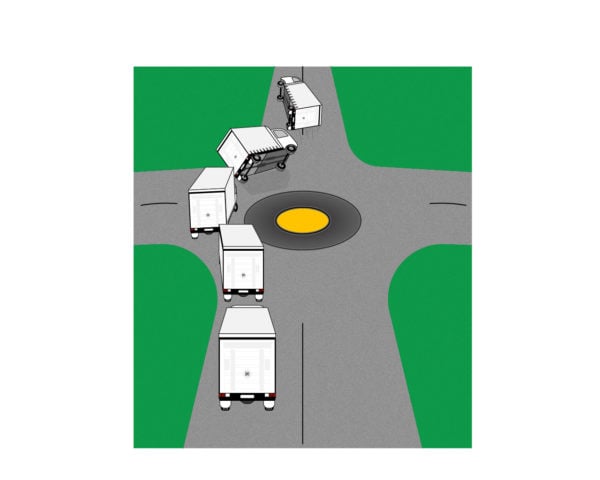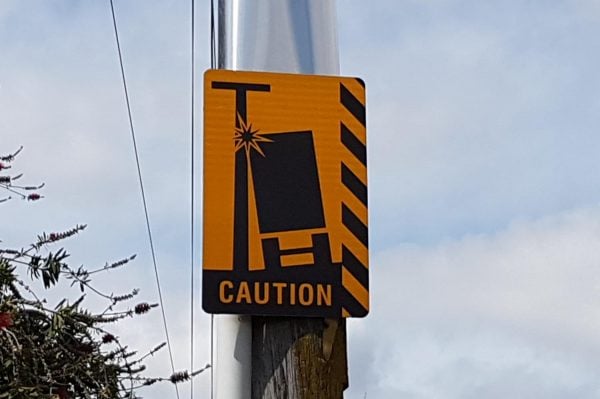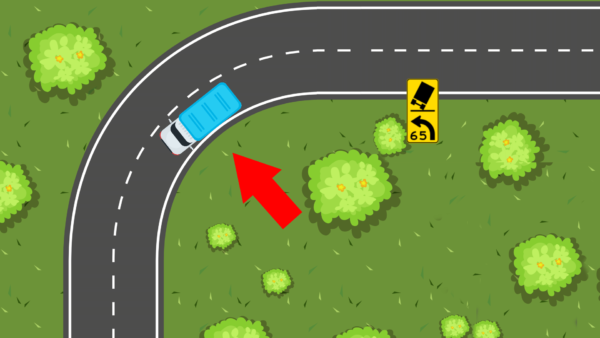A rollover accident is where a vehicle either tips on its side or completely rolls onto its roof (or further). To achieve this, the vehicle must become unstable enough and have a high enough centre of gravity. Heavy vehicle drivers are rarely taught what factors cause a rollover, unless they have done a rollover prevention course. Road design can contribute to these sorts of accidents, but first, let’s explore how a rollover can happen in the first place.
How do rollover accidents happen?
A rollover accident is categorised as either untripped (caused by steering input, speed and friction) or tripped (caused by an external object). In passenger vehicles, tripped accidents are the most common, but in heavy vehicles it is more likely to be untripped accidents.
Collision with another vehicle
As we explained, this is a tripped rollover and there are three common scenarios when the rollover is caused solely by collision with another vehicle:
- A larger vehicle runs up and over the smaller vehicle, i.e. the smaller vehicle acts as a ramp
- A vehicle’s wheel (or both vehicles’ wheels) act together to lift one of the vehicles (usually happens in a side-swipe collision)
- In a small overlap crash, the deformation of the vehicle lifts it (see the Jeep video below)
In each of these cases, the steering input and friction on the road plays much less of a role.
Collision with an object
An object can act like a ramp on one side if it’s small enough, or if the small overlap scenario happens, as explained above.
Weight transfer
This is an untripped scenario. Trucks are particularly susceptible to this. A semitrailer or pull trailer will have a static roll threshold of 0.35G. This means that, as long as the trailer isn’t overloaded, it should be able to support a lateral load of 0.35G without tipping. Unfortunately, it’s possible to exceed the SRT with a rapid change in direction.
The same applies with rigid trucks. A change in direction can accentuate weight transfer from one side of the truck to another, tipping it over, as shown below.

This commonly occurs at roundabouts, chicanes and S-bends where a high-sided vehicle will turn one way then another in quick succession.
These issues with weight transfer are exacerbated when a vehicle isn’t loaded correctly. It’s recommended that all truck drivers learn how to load a heavy vehicle correctly.
Moose test
The moose test simulates you having to weave around an object at high speed. Almost all modern vehicles will pass this test, although as you can see below, the Jeep nearly didn’t. This is an extreme form of weight transfer that we explained above.
Slide and dig in
If the vehicle starts to slide sideways, but then digs into the road’s surface or hits an obstacle (e.g. a rock or kerb), then it’s likely it will roll over. This is a tripped scenario as the vehicle may just have slid had it not hit the object. This is the most common cause of rollover, accounting for at least half and perhaps up to three-quarters of all cases.
Overcorrection
If the vehicle starts to slide, but the driver overcorrects it so it quickly whips the other way, this is also a rapid weight transfer situation.
Crossing uneven terrain
This scenario typically occurs during off-road driving. If the vehicle tilts any more than around 33%, its likelihood of rolling is very high.
Ground instability
This scenario commonly happens when a vehicle parks on the side of the road next to a bank. The weight of the vehicle causes the bank to start subsiding and eventually the vehicle rolls over the bank.
Too fast
Entering a corner too fast can cause a rollover, particularly for trucks. The yellow advisory speed signs you see on a corner describe the recommended speed to keep the centrifugal g-force at 0.22G. Bearing in mind that the static rollover threshold is 0.35G, this gives some buffer, but truck drivers should still aim to travel at 10km/h under the advisory speed for that corner.
Jackknifing trailer
If a trailer begins to sway, it can exert enough force on the towing vehicle to spin it around and, then provide enough inertia to tip the towing vehicle over.
How does road design affect rollover risk?
Direction changes
Roads that have rapid direction changes can cause weight shifts that induce a rollover in heavy vehicles with a high centre of gravity. This includes roundabouts, chicanes (where the road narrows through a left-right or right-left) and natural left-right or right-left bends on a road.
Camber
Where the road’s surface slopes towards the outside of the curve, it will take less centrifugal force to tip the vehicle over as it is already leaning. This is common on roundabouts (so that the water drains to the edge) and on steep hills when there’s a hairpin. Roads should be engineered to remove as much adverse camber as possible.

Changes in road friction and elevation
Where a vehicle could start sliding due to low friction, but then suddenly grip due to a high friction section of road, this immediate grip can cause instability.
Bumps mid-corner can unsettle a vehicle that is already turning.
Exposed areas
Bridges and plains where there are high winds can be difficult for high-sided vehicles which can be blown onto their side. This can happen when a vehicle comes out of a ‘wind shadow‘, e.g. a hill, buildings or a tunnel can create shade from a strong side wind and when the vehicle exits this shade it is hit by strong gusts which blows it over.

Coastal roads can be subject to strong gusts, too
Kerbs, barriers and culverts
A kerb that is as little as 100mm high that is hit at speed can tip a vehicle over. Barriers that slope upwards will act like a ramp. Culverts with ramps can cause issues on narrow roads where a driver may need to move over to let another vehicle pass.
Soft verges
Heavy vehicles can sink into soft ground on verges.
Unmowed verges
On narrow roads, where large vehicles might need to move over to let each other pass, long grass can hide steeper slopes into a ditch, or hidden pipes.
Eliminating rollover accidents
A combination of slower speeds when cornering, technology to prevent loss of control, good load restraint practices and collision avoidance systems can prevent drivers from getting into rollover situation.
Road designers can ensure that road shoulders are clearly marked and mowed and that they are stable. Corners must be clearly signposted and easy for a driver to read so that they pick an appropriate speed.

